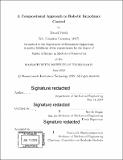A compositional approach to robotic impedance control
Author(s)
Verdi, David,S.M.Massachusetts Institute of Technology.
Download1136489464-MIT.pdf (12.15Mb)
Other Contributors
Massachusetts Institute of Technology. Department of Mechanical Engineering.
Advisor
Neville Hogan.
Terms of use
Metadata
Show full item recordAbstract
While the gap between robot and human performance is rapidly closing, humans still vastly outperform robots at dynamic interaction tasks, particularly those which involve manipulation into kinematic singularities, and those which might involve collaborative or closed kinematic chain manipulation with multiple actuators. In this work, compositional impedance control, or linearly superimposing impedance controllers on a robot, is presented as a step towards closing this performance gap. First, an overview of compositional impedance control is provided, along with a discussion of the control framework's applications to redundancy resolution, controlling closed kinematic chains, managing collaborative manipulation, and tackling high-DOF manipulation tasks. This control scheme was implemented on a Baxter Research Robot, and a series of system identification experiments were conducted to determine how well the robot was able to render the desired impedance parameters, and how well those parameters linearly superimposed between two arms collaboratively manipulating an object. Commanded static stiffness was found to be delivered by each individual arm to within a 2% error, while the linear superposition was verified to within 3% error. Commanded endpoint damping was found to be delivered by the robot with a 17% and 57% error by the left arm and right arm respectively. Linear superposition for damping was verified to within 7% error. Using this compositional impedance control framework, sample manipulation tasks such as closed-chain manipulation into singularity, and high-speed closed-chain cloth manipulation (in the form of robotic shoe-shining) were implemented. Finally, nullspace projection methods for redundant manipulators are discussed, and an impedance based implementation of the nullspace projection method is presented.
Description
Thesis: S.M., Massachusetts Institute of Technology, Department of Mechanical Engineering, 2019 Cataloged from PDF version of thesis. Includes bibliographical references (pages 121-129).
Date issued
2019Department
Massachusetts Institute of Technology. Department of Mechanical EngineeringPublisher
Massachusetts Institute of Technology
Keywords
Mechanical Engineering.